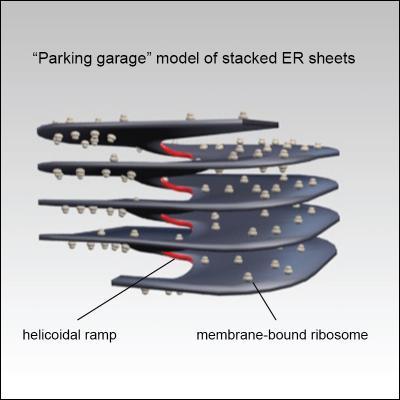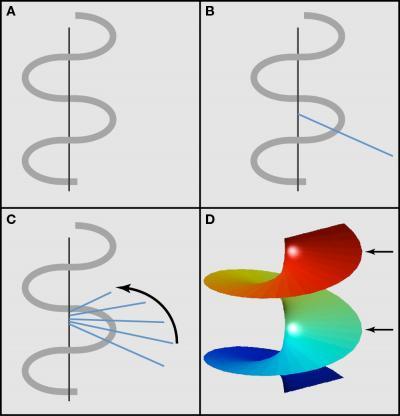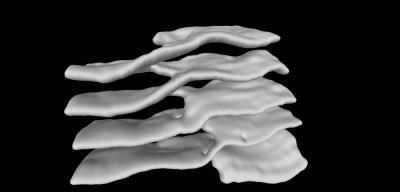The endoplasmic reticulum (ER) is the protein-making factory within cells consisting of tightly stacked sheets of membrane studded with the molecules that make proteins. In a study published July 18th by Cell Press in the journal Cell, researchers have refined a new microscopy imaging method to visualize exactly how the ER sheets are stacked, revealing that the 3D structure of the sheets resembles a parking garage with helical ramps connecting the different levels. This structure allows for the dense packing of ER sheets, maximizing the amount of space available for protein synthesis within the small confines of a cell.
"The geometry of the ER is so complex that its details have never been fully described, even now, 60 years after its discovery," says study author Mark Terasaki of the University of Connecticut Health Center. "Our findings are likely to lead to new insights into the functioning of this important organelle."

The endoplasmic reticulum (ER) is the protein-making factory within cells consisting of tightly stacked sheets of membrane studded with the molecules that make proteins. In a study published July 18th by Cell Press in the journal Cell, researchers have refined a new microscopy imaging method to visualize exactly how the ER sheets are stacked, revealing that the 3D structure of the sheets resembles a parking garage with helical ramps connecting the different levels. This structure allows for the dense packing of ER sheets, maximizing the amount of space available for protein synthesis within the small confines of a cell.
(Photo Credit: Cell, Terasaki et al.)
Jeff Lichtman and colleagues at Harvard developed an improved technique for staining ER membrane sheets that allowed them to visualize the 3D structure in unprecedented detail. Applying this new scanning electron microscopy method to mouse neurons and salivary gland cells, Terasaki and his colleague Art Hand, along with Tom Rapoport of Harvard Medical School, discovered that ER sheets form a continuous membrane system consisting of stacked levels connected by a well-known geometric shape called the helicoid, which resembles a spiral staircase.

The endoplasmic reticulum (ER) is the protein-making factory within cells consisting of tightly stacked sheets of membrane studded with the molecules that make proteins. In a study published July 18th by Cell Press in the journal Cell, researchers have refined a new microscopy imaging method to visualize exactly how the ER sheets are stacked, revealing that the 3D structure of the sheets resembles a parking garage with helical ramps connecting the different levels. This structure allows for the dense packing of ER sheets, maximizing the amount of space available for protein synthesis within the small confines of a cell.
(Photo Credit: Cell, Terasaki et al.)
Moreover, a theoretical model developed by collaborators Michael Kozlov and Tom Shemesh revealed that this "parking garage" structure optimizes the dense packing of ER sheets and thus maximizes the number of protein-synthesizing molecules called ribosomes within the restricted space of a cell. When a cell needs to secrete more proteins, it can reduce the distances between sheets to pack even more membrane into the same space. Think of it as a parking garage that can add more levels as it gets full. "The theory explains that this structure is seen in nature because it maximizes the cell's ability to make a large number of proteins while minimizing the energetic cost to the cell," Rapoport says. "The paper is an excellent example for the role that theory can play in biology."

The endoplasmic reticulum (ER) is the protein-making factory within cells consisting of tightly stacked sheets of membrane studded with the molecules that make proteins. In a study published July 18th by Cell Press in the journal Cell, researchers have refined a new microscopy imaging method to visualize exactly how the ER sheets are stacked, revealing that the 3D structure of the sheets resembles a parking garage with helical ramps connecting the different levels. This structure allows for the dense packing of ER sheets, maximizing the amount of space available for protein synthesis within the small confines of a cell.
(Photo Credit: Cell, Terasaki et al.)
Source: Cell Press